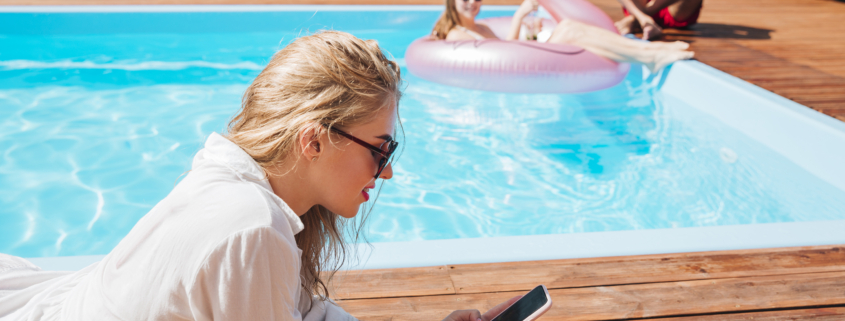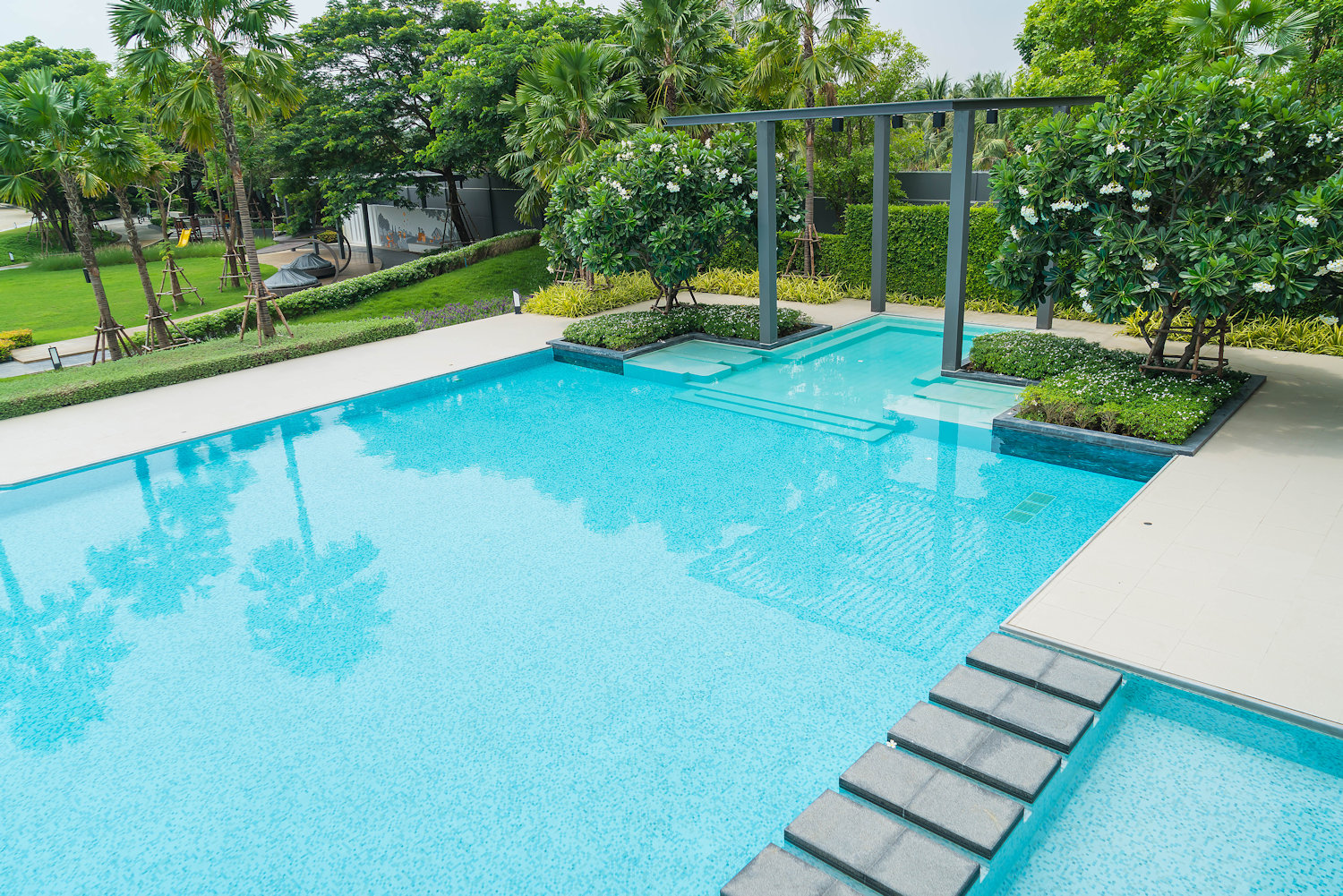Everything You Need to Know About Your Sand Filter
If your pool has a sand filter, you want to change it every three to five years. You can do it yourself, and we’ll tell you everything you need to know about your sand filter below. You can also have us do it for you! Our expert team is well-equipped to do it efficiently and correctly. If you’d like our service staff to do it, please complete the form at the bottom of this article.
Now, let’s get to sand filter info.
What Does a Sand Filter Do?
Your sand filter pushes the pool water through layers of sand. This means the sand is your filtration medium in your pool’s filter tank. Because the sand grains have sharp edges, they capture the contaminants as the water moves through the filter.
Your sand filter uses the graded layers of sand to clean your pool water. It looks like this:
- coarse sand on the bottom
- medium sand
- fine sand
- very fine silica sand on the top
The size of the sand granules is absolutely vital for your pool to filter efficiently. If your sand granules are too big, your filtering is less efficient. Yet, if the sand is too small, you risk clogging your filter quite quickly.
Here are some tips for more optimal filtering performance:
- Use chemical flocculants of diatomaceous earth (DE) powder over the top layer of sand. The flocculants attract microscopic debris that is floating. The flocculants help cluster the particles together into large chunks that sink. You can then vacuum them up. DE (pulverized plankton fossils called diatoms) coats your filter element to collect impurities.
Here’s How to Change Your Sand
This is a complex process, and if you’re not ready to tackle it, please know that we can do it for you! Simply complete the form below.
It is worth noting that you don’t have to change your sand very often. Every three to five years should do it. The following steps are from our partners at Swimmingpool.com.
Step 1: Get the Right Equipment
Be sure you have everything you need on hand before you begin the process. Your list of essentials can include:
- sand
- a replacement O-ring between the valve and the tank
- Teflon tape
- lubricant
- unions
Only use pool filter sand that is approved by your manufacturer. If you have any questions about what kind of sand you need, check with Fiesta.
Pro tip: Your pool filter has many small yet important components. Always place items like your filter drain cap in a safe, memorable place so you can find them easily during reassembly.
Step 2: Turn the Power Off
Turn off the pool pump and timer (if you have one). Better yet, shut off the power to the pump at the circuit breaker.
Step 3: Drain the Tank
Remove the drain cap at the bottom of your filter tank to release the pressure in the filter and drain the water. Give the drain cap at the bottom of the tank just half a turn counter-clockwise to let out all the air. After a burst of air pressure, remove the cap to drain out the water.
If you don’t want the water emptying directly onto the ground, quickly attach a hose over the drain after you remove the cap to direct the draining water elsewhere.
Step 4: Remove the Multiport Valve
Disconnect the pump, return, and waste hoses fixed to the multiport valve at the top of your filter. After those port attachments are off, take out the multiport valve flange clamp that secures the filter in place. Unscrew the bolts that separate the clamp, and pull deliberately and consistently to lift the valve off the pipe.
If your multiport valve has unions, just unscrew them from the multiport valve. If you do not have unions, you’ll need to cut the pipes running to and from your filter. It might be a good time to install unions before reassembling to make future maintenance easier. Make sure you leave enough exposed pipe after the cut to add both sides of the unions.
Pro tip: Use a very gentle twist to pull the valve off the pipe. Yanking too hard will likely break the lateral pipes at the bottom of the tank.
Step 5: Remove the Old Sand
As soon as you disconnect the pipe from the multiport valve, tape the end of the pipe closed to prevent sand from entering it and clogging the laterals. After you tape off the pipe, empty out all the existing sand.
Scoop it out with a plastic cup – or vacuum it out with a shop vac – until the top of the laterals at the bottom of the tank are visible.
Step 6. Withdraw the Lateral Assembly and Pipe
Slowly rotate the 10 lateral pipes upwards, then smoothly pull the lateral assembly and pipe out of the rest of the sand. Inspect the laterals for damage and replace any that look broken or worn out. Clogged laterals should be soaked in a bucket of cleaning solution for a few hours, then thoroughly rinsed and reinstalled onto the assembly.
Step 7: Wash the Tank
Thoroughly wash out the tank with a garden hose. Check the drain cap, and swap it out with a new one it if you find any cracks. Fill the filter tank hallway up with water to provide a cushion and protect the laterals from getting clogged when you pour in the new sand.
Step 8: Replace the Lateral Assembly and Pipe
Insert the lateral assembly and pipe back into the tank with the 10 laterals rotated up. Once the lateral assembly is secured, turn all the laterals 90 degrees back to their downward position.
Step 9: Add Fresh Sand
Tape off the top of the pipe to prevent sand from entering and clogging the laterals. Keep the pipe centered in the tank, and carefully and slowly pour sand into the filter unit. Add enough sand so that the laterals are completely covered. Level the sand as you pour to ensure even sand distribution for effective filtration and water circulation.
Pro tip: When adding new sand, take care not to lift the lateral assembly and pipe off the bottom of the tank. You won’t be able to push it back down without rotating the laterals up, and upward-facing laterals will prevent proper filtering.
Step 10: Inspect (and possibly replace) the O-Ring.
Remove the O-ring at the bottom of the multiport valve and inspect for excessive wear and tear. Since you only perform this procedure every three to five years or so, it’s a smart choice to go ahead and replace the O-ring now, even if yours is in decent shape. O-rings are really inexpensive, and they do wear out.
Of course, if you don’t replace the O-ring, make sure to lubricate it sparingly with a silicone-based lubricant.
Step 11: Re-set the Multiport Control Valve
Remove the tape from the end of the pipe, and carefully set the multiport control valve back in its original position on the central pipe. Secure the valve clamps around the tank and tighten them into place. Reconnect the unions with the pool pump and the return ports.
(If your filter doesn’t have unions, glue the pipes back together with straight couplers.)
Step 12: Backwash the Filter
With the pump still switched off, rotate the valve handle to the “Backwash” setting and then turn on the pump. After it’s fully primed, run the pool pump for about two minutes to flush out the impurities in the water and the finer sand particles from the sand media and to ensure that your pool water waste exits at the right place.
Once the backwash water runs clear and clean, turn the pool pump off. Switch the multiport valve to “Rinse,” then turn the pump back on. After about a minute, the water in the sight glass should be clear.
Step 13: Enjoy!
Turn the pool pump back off and set the valve to “Filter” (the normal operating mode). Turn the pump back on, and get ready to enjoy your swim!
We Can Do It For You!
If that all sounds too complicated (and it is!), we are happy to do it for you!
Simply complete the form, and we’ll get back to you shortly.











